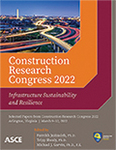Knowledge and Perception of Single-Family Residential Building Resilience and Its Impact on Disaster Evacuations Decisions
Publication: Construction Research Congress 2022
ABSTRACT
Hurricane is one of the major coastal disasters and causes loss of life and property damage. Resilient residential buildings are essential to protect the affected communities in the face of hurricanes. Residents’ knowledge of the building structures in which they stay and their perception of the risks are critical to their disaster preparation and response, such as rational evacuation decisions. In order to better understand whether and how people’s knowledge and perception of building structures affect their evacuation decisions, an online survey was created and distributed. The survey mainly includes two parts. In the first part, respondents’ knowledge on the structure characteristics (e.g., building materials, roof style) of their homes were tested. In the second part, respondents were asked if they were to stay at home or evacuate under hypothetical hurricane scenarios. The survey was distributed to 452 undergraduate civil and environmental engineering students at the University of Connecticut. Seventy valid responses were collected. Several findings were identified through analysis of the survey responses. First, it was found that many respondents lacked basic knowledge of crucial structural characteristics of their homes. Second, it was found that over 50% of the respondents overestimated the structural performance of their homes in the face of hurricanes. The lack of knowledge and misperception could lead to irrational evacuation decisions of respondents in the hypothetical scenarios. Finally, it was identified that providing additional information (e.g., pictures of damage from previous hurricanes) to the respondents could lead to more rational decision making.
Get full access to this article
View all available purchase options and get full access to this chapter.
REFERENCES
Ayscue, J. K. 1996. “Hurricane Damage to Residential Structures: Risk and Mitigation.” The Johns Hopkins University, 1–41. http://www.colorado.edu/hazards/publications/wp/wp94/wp94.html#damagemitigation.
Big Al. 2019. “Best Roof Types for Florida & Texas: Miami, Orlando, Houston.” Roof Cost Estimator. 2019. Accessed August 19, 2019. https://www.roofcostestimator.com/top-15-roof-types-and-their-pros-cons/.
Bloomberg, M. R., and C. C. Quinn. 2013. “Building Resiliency Task Force.” http://www.urbangreencouncil.org/BuildingResiliency.
Collins, J., R. Ersing, and A. Polen. 2017. “Evacuation Decision-Making during Hurricane Matthew: An Assessment of the Effects of Social Connections.” Weather, Climate, and Society 9 (4): 769–76. https://doi.org/10.1175/WCAS-D-17-0047.1.
Evans, M. 2019. Hurricanes : Protect Your Windows and Doors.
FEMA. 2008. “Flood Damage-Resistant Materials Requirements.” Technical Bulletin 2, no. August. https://doi.org/10.1016/j.ndteint.2013.07.002.
FEMA. 2009a. “Local Officials Guide for Coastal Construction: Windows, Doors, and Opening Protection,” 1–16. https://www.fema.gov/media-library/assets/documents/16036.
FEMA. 2009b. “Recommended Residential Construction for Coastal Areas: Building on Strong and Safe Foundations,” no. December. http://www.fema.gov/library/viewRecord.do?id=1853.
FEMA. 2009c. “Hurricane Ike in Texas and Louisiana”, no. April.
FEMA. 2010. “Home Builder’s Guide to Coastal Construction :.,” no. December: P-499.
Goldberg, M. H., J. R. Marlon, S. A. Rosenthal, and A. Leiserowitz. 2020. “A Meta-Cognitive Approach to Predicting Hurricane Evacuation Behavior.” Environmental Communication. https://doi.org/10.1080/17524032.2019.1687100.
Hatzikyriakou, A., N. Lin, J. Gong, S. Xian, X. Hu, and A. Kennedy. 2016. “Component-Based Vulnerability Analysis for Residential Structures Subjected to Storm Surge Impact from Hurricane Sandy.” Natural Hazards Review 17 (1): 1–15. https://doi.org/10.1061/(ASCE)NH.1527-6996.0000205.
Hawley, J. 2018. Our Doors Are Storm-Ready, no. 239.
Heath, S. E., P. H. Kass, A. M. Beck, and L. T. Glickman. 2001. “Human and Pet-Related Risk Factors for Household Evacuation Failure during a Natural Disaster.” American Journal of Epidemiology 153 (7): 659–65. https://doi.org/10.1093/aje/153.7.659.
Kyne, D., A. S. Lomeli, W. Donner, and E. Zuloaga. 2018. “Who Will Stay, Who Will Leave: Decision-Making of Residents Living in Potential Hurricane Impact Areas During a Hypothetical Hurricane Event in the Rio Grande Valley.” Journal of Homeland Security and Emergency Management 15 (2). https://doi.org/10.1515/jhsem-2017-0010.
Lindell, M. K., J.-C. Lu, and C. S. Prater. 2005. “Household Decision Making and Evacuation in Response to Hurricane Lili.” Natural Hazards Review. Natural Hazards Review, Vol. 6, Issue 4. https://doi.org/10.1061/(asce)1527-6988(2005)6:4(171).
NOAA. 2020. “Weather Disasters and Costs.” National Oceanic and Atmospheric Administration, Office for Coastal Management, 1–6. https://coast.noaa.gov/states/fast-facts/weather-disasters.html.
NOAA, and NHC. 2021. “Saffir-Simpson Hurricane Wind Scale.Pdf.” 2021. https://www.nhc.noaa.gov/aboutsshws.php.
Taher, R. 2010. Improved Building Practices for Hurricane and Earthquake Prone Areas, 1–21.
The Builder. 2019. “Built to Withstand Hurricanes- Grenada Builder’s Guide.” 2019. Accessed August 13, 2019. www.buildgrenada.com.
Information & Authors
Information
Published In
History
Published online: Mar 7, 2022
Authors
Metrics & Citations
Metrics
Citations
Download citation
If you have the appropriate software installed, you can download article citation data to the citation manager of your choice. Simply select your manager software from the list below and click Download.
